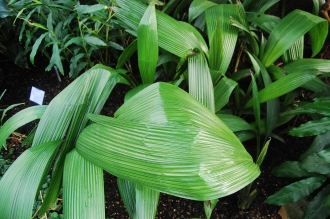Position: Full sun to partial shade
Flowering period: Summer
Soil: Moist, well drained
Eventual Height: 1m
Eventual Spread: 1m
Hardiness: 9a, 9b, 10a, 10b, 11, 12
Family: Hypoxidaceae
Curculigo capitulata is an evergreen tropical perennial with a clump forming habit. At the lower end of its hardiness rating it will loose its leaves during the winter months. Its light green leaves are lanceolate with entire margins and pleated along their length, up to 90cm long and 14cm across. Its yellow flowers are star shaped and appear in clusters near the base of its stems. Its roots have fleshy rhizomes which aids its spread.
Curculigo capitulata, commonly known as Palm Grass or Whale Back, is native to east, south and south east Asia. In its native habitat it grows as a woodland understory plant in tropical forests. Curculigo capitulata is synonymous with Molineria capitulata.
The etymological root of the binomial name Curculigo is derived from the Latin curculio menaing ‘weevil’, in reference to its fruit. Capitulata is derived from the Latin capitulatus meaning ‘having a small head’.
The landscape architect may find Curculigo capitulata useful as an attractive foliage with large architectural leaves. It may be grown as a houseplant in full sun to shaded conditions.
Ecologically, Curculigo capitulata is of little value to UK wildlife.
Curculigo capitulata prefers moist, humus rich, well-drained soils. It tolerates most pH of soil.
When maintaining Curculigo capitulata as a houseplant its soil should be watered regularly. Watering should be reduced during the winter months. Its preferred active growing temperature rages from between 16ºc to 24ºc, it will tolerate a temperature as low as 0ºc. Feeding with weak fertiliser solution should be carried out once a month during the growing season.
![]()
Landscape Architecture






Leave a comment